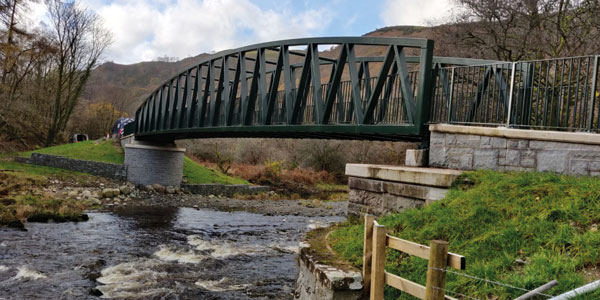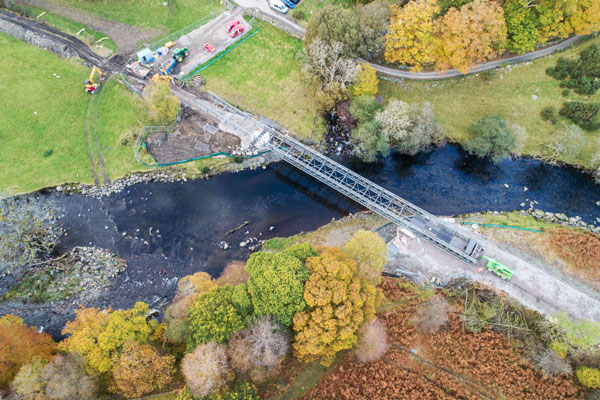SSDA Awards
MERIT: Brundholme and Low Pearson Bridges

Two new steel bridges have been installed as part of the reconstruction of the Lake District’s popular Railway Trail walking route.
FACT FILE
Architect: Capita
Structural engineer: Beaver Bridges Ltd
Steelwork contractor: Jamestown Manufacturing Ltd
Main contractor: Cubby Construction Ltd
Client: Lake District National Park Authority
Following the devastating floods caused by storm Desmond in 2015, two Victorian railway bridges, which formed integral parts of the Railway Trail – a walking route that connects Keswick to Threlkeld – were washed away.
It was important for Lake District National Park Authority to get the trail reopened as soon as possible and subsequently, Beaver Bridges was awarded the contract for design, fabrication and erection of two steel truss bridges over the Greta river at two sites, Brundholme and Low Pearson.
The project team developed a build sequence, which successfully eliminated the need for disruptive concrete works in the river, as well as reducing the programme time and associated costs.
Because the Low Pearson site could only be accessed via the Brundholme site, the proposal included a modular temporary steel bridge, adapted to fit on the permanent foundations at the latter site, and designed to accommodate construction traffic up to 44t in weight.
This proposal improved the speed of construction of the paths and roadway to the Low Pearson site, enabling delivery of prefabricated bridge elements and thereby improving efficiency of the onsite programme.
Applying the principles of DfMA (Design for Manufacture & Assembly), the Low Pearson bridge was fabricated in three sections, delivered to a compound adjacent to the Brundholme temporary bridge, loaded onto temporary vehicle bogies and moved to site by tractor.

Once onsite, the sections were bolted together, fitted with a unique temporary launch nose adapter, temporary launch frame and lower boom launch runway beams, which enabled the bridge to be launched into final position without damaging the permanent works.
Once the bridge was in its final position, the launch rollers, launch nose, temporary launch frame and lower boom runway beams were all removed and used again later.
The same innovative system was used for the Brundholme bridge, with the structure being assembled on the far bank of the temporary bridge. For this bridge, the same temporary lower boom runway beams and frame were used, but this time they were spliced to the end of the site’s temporary bridge.
This enabled the same operation to both launch the new permanent bridge, and de-launch the temporary access bridge, improving programme and eliminating unnecessary risk.
Once the new bridge was in its final position, the temporary launch frame and lower boom runway beams were removed and recovered for recycling. Adding more sustainability credentials to the project, the steel temporary bridge, launch nose and rollers were all returned to the supplier to be reused on other projects.
In summary, the judges say the team cleverly adapted existing erection techniques to address the inaccessibility of the two sites, reducing the installation cost and minimising any detrimental impact on the surrounding area, which is inside the Lake District National Park.








